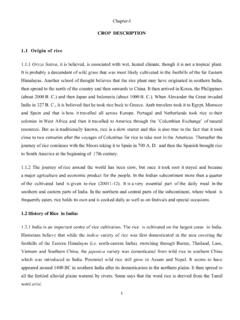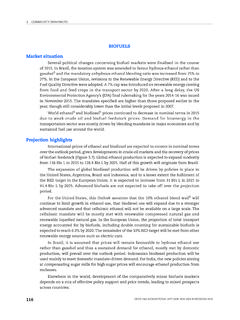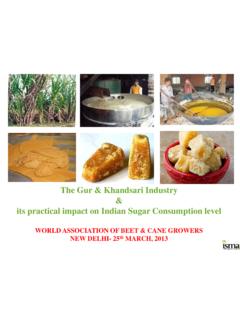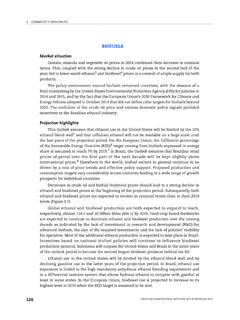Transcription of Status Paper on Sugarcane - Farmer
1 Status Paper on Sugarcane By DIRECTORATE OF Sugarcane DEVELOPMENT GOVT. OF INDIA, Ministry of Agriculture, (Department of Agriculture & Cooperation) 8TH FLOOR, KENDRIYA BHAVAN, ALIGANJ, LUCKNOW (UP) January 2013 2 Origin of the crop: Cultivation of Sugarcane in India dates back to the Vedic period. The earliest mention of Sugarcane cultivation is found in Indian writings of the period 1400 to 1000 It is now widely accepted that India is the original home of Saccharum species. Saccharum barberi and Polynesian group of island especially New Guinea is the centre of origin of S.
2 Officinarum. It belongs to family Gramineae (Poaceae), class monocotyledons and order glumaceae sub family panicoidae, tribe Andripogoneae and sub tribe saccharininea. The cultivated canes belong to two main groups: (a) thin, hardy north Indian types and and (b) thick, juicy noble canes Saccharum officinarum. Highly prized cane is S. officinarum. Importance of Sugarcane : In agriculture sector, Sugarcane shared is about 7% of the total value of agriculture out put and occupied about of India s gross cropped area during 2006-07. Sugarcane provides raw material for the second largest agro-based industry after textile.
3 About 527 working sugar factories with total installed annual sugar production capacity of about 242 lakh tonnes are located in the country during 2010-11. Scientific name of Sugarcane : The genus Saccharum has five important species viz., 1. Saccharum officinarum, 2. S. Sinense, 3. , 4. , 5. The first three species are the cultivated species and the last two are wild ones. S. officinarum species is widely cultivated in India because of high sucrose content. Morphology of Sugarcane : Sugarcane is a tall perennial plant growing erect even up to 5 or 6 metres and produce multiple stems.
4 The plant is composed of four principal parts, root system, stalk, leaves and inflorescence. Sheath is Green with red blotches; moderate to heavy bloom; scarious border prominent; sheath splitting occasional Clasping; Spines present on the middle of the sheath; deciduous. Blade Joint or Transverse Mark is Purplish green; medium: fair bloom. Ligule: Medium;Crescentiform; symmetrical; gradually tapering towards the edges. The inflorescence of Sugarcane generally called the 'arrow' is an open panicle. It is long (30 centimeter or more) and tapering. Cane is Medium-thick; slightly staggered; slightly oval in cross section, internal tissue yellow with purple tinge: rind hard; pith present as small cavity.
5 Node & buds are slightly depressed; leaf scar slightly inclined. Buds are medium, plumpy, ovate; occasionally hairs at the tip of the bud noticed; inserted at leaf scar. Sugarcane is a C4 plant having high efficiency in storing solar energy and most efficient converter of solar energy to sucrose. Sugarcane has essentially four growth phases: phase, 2. Tillering phase, 3. Grand growth phase, 4. Maturity and ripening phase. ( ) Nutritional value of Sugarcane : The juice Sugarcane per serving ( grams) contain kJ ( kcal), g, g, mg (1%), Iron mg (3%), mg (1%), mg (1%) Source: Nutrient Information from ESHA Research Important regions/ zones for Sugarcane cultivation in India: Broadly there are two distinct agro-climatic regions of Sugarcane cultivation in India, viz.
6 , tropical and subtropical. However, five agro-climatic zones have been identified mainly for the purpose of varietal development. They are (i)North Western Zone (ii) North Central Zone (iii) North Eastern Zone (iv) Peninsular Zone (v) Coastal Zone. Tropical region Shared about 45% and 55% of the total Sugarcane area and production in the country, respectively along with the average productivity of 77 t/ha (2011-3 12). Sub-tropical region accounted for about 55% and 45% of total area and production of Sugarcane with an average productivity about 63 t/ha (2011-12) Tropical Sugarcane region: The tropical Sugarcane region consists of Sugarcane agro climatic zone 4 (peninsular zone) and 5(Coastal zone) which includes the states of Maharashtra, Andhra Pradesh, Tamil Nadu, Karnataka, Gujarat, Madhya Pradesh, Goa, Pondicherry and Kerala.
7 Sub-tropical Sugarcane region: Around 55 per cent of total cane area in the country is in the sub-tropics. , Bihar, Haryana and Punjab comes under this region. Crop distribution: Sugarcane growing countries of the world are lying between the latitude north and south of the equator extending from tropical to sub-tropical zones. In India Sugarcane is cultivated all over the country from latitude 80 N to 330 N, except cold hilly areas like Kashmir valley, Himachal Pradesh and Arunachal Pradesh. Demand and supply scenario of Sugarcane produce: Ssugar is the major produce of Sugarcane .
8 The domestic demand of sugar is rotating around 22-23 million tonnes annually, where as the production of sugar in India during last 5 years is rotating around to Million ton. Maharashtra is the largest producer of sugar contribute about 34% of sugar in the country followed by Uttar Pradesh. Area, production and yield of Sugarcane in major growing states: In Tropical zone Maharashtra is the major Sugarcane growing state covering about lakh ha area with production of Million ton, whereas the productivity of Tamil Nadu is highest in tropical zones.
9 Uttar Pradesh is the highest Sugarcane producing State in sub tropical zone having area about Lakh ha with the production of Million Ton cane whereas Haryana has highest productivity of Sugarcane in Sub tropical zone. Area, production and yield of Sugarcane in major growing countries: Brazil is major Sugarcane producing country with an area about lakh ha and production of about Million ton followed by India. Sugarcane productivity is highest in Colombia ( t/ha) followed by Philippines ( t/ha). Amongst 10 major producing country Colombia has the highest yield of Sugarcane due to the richest biodiversities in the world and has access to multiple climates.
10 The yield gap of Sugarcane in India with respect to 10 major Sugarcane producing countries during the last 5 years is ranges t/ha. Export import Status of Sugarcane produce: Sugarcane as such is neither exported nor imported, however the sugar which is a main produce of Sugarcane crop is exported and imported as per the Government policies. As per Cooperative Sugar ( , Dec. 2012) the total export of sugar during 2010-11 is lakh ton value Rs. thousand crore and import is lakh ton for value Rs. crore during the same year. Varietal Development: Released and notified varieties of Sugarcane Name of variety Year of release State(s)for which recommended Key characteristics (like duration, yield, level, quality characteristics, etc) Maturity Cane yield (t/ha) Sucrose(%) Notification No.










![Index [www.tongaat.co.za]](/cache/preview/f/7/7/5/c/d/4/1/thumb-f775cd41d646a3d64d3ce917aaad62e5.jpg)
